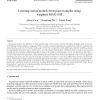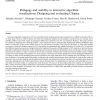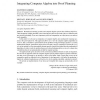1235 search results - page 228 / 247 » Formalizing information security knowledge |
SIGMOD
2010
ACM
13 years 7 months ago
2010
ACM
Radio Frequency Identification (RFID) technologies are used in many applications for data collection. However, raw RFID readings are usually of low quality and may contain many an...
AI
2007
Springer
13 years 7 months ago
2007
Springer
AI planning requires the definition of action models using a formal action and plan description language, such as the standard Planning Domain Definition Language (PDDL), as inp...
IWC
2008
13 years 7 months ago
2008
Interactive algorithm visualizations (AVs) are powerful tools for teaching and learning concepts that are difficult to describe with static media alone. However, while countless A...
JAR
1998
13 years 7 months ago
1998
Mechanized reasoning systems and computer algebra systems have different objectives. Their integration is highly desirable, since formal proofs often involve both of the two differ...
SAC
2008
ACM
13 years 7 months ago
2008
ACM
Users of the web are increasingly interested in tracking the appearance of new postings rather than locating existing knowledge. Coupled with this is the emergence of the Web 2.0 ...



